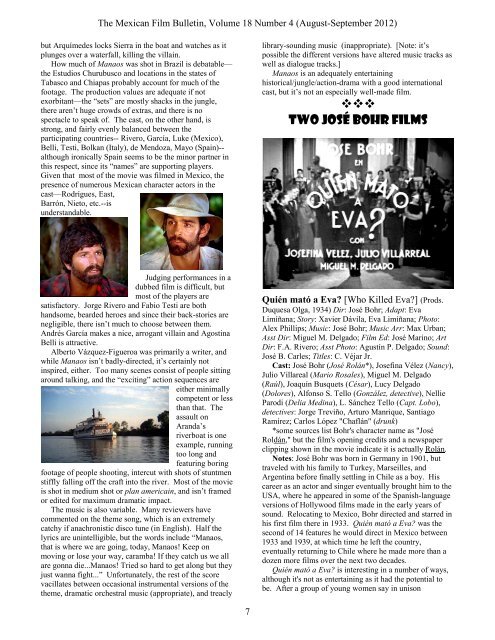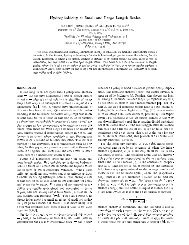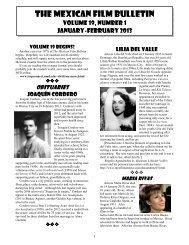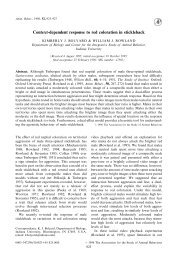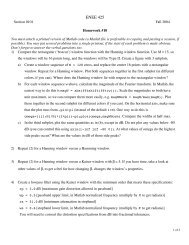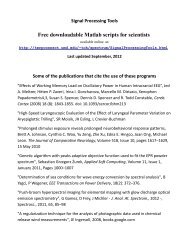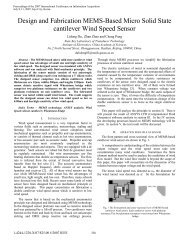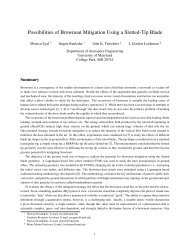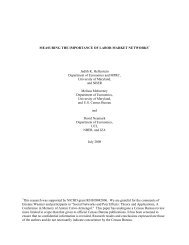Bonus Jorge Luke Film Review - TerpConnect
Bonus Jorge Luke Film Review - TerpConnect
Bonus Jorge Luke Film Review - TerpConnect
Create successful ePaper yourself
Turn your PDF publications into a flip-book with our unique Google optimized e-Paper software.
The Mexican <strong>Film</strong> Bulletin, Volume 18 Number 4 (August-September 2012)<br />
but Arquímedes locks Sierra in the boat and watches as it<br />
plunges over a waterfall, killing the villain.<br />
How much of Manaos was shot in Brazil is debatable—<br />
the Estudios Churubusco and locations in the states of<br />
Tabasco and Chiapas probably account for much of the<br />
footage. The production values are adequate if not<br />
exorbitant—the “sets” are mostly shacks in the jungle,<br />
there aren’t huge crowds of extras, and there is no<br />
spectacle to speak of. The cast, on the other hand, is<br />
strong, and fairly evenly balanced between the<br />
participating countries-- Rivero, García, <strong>Luke</strong> (Mexico),<br />
Belli, Testi, Bolkan (Italy), de Mendoza, Mayo (Spain)--<br />
although ironically Spain seems to be the minor partner in<br />
this respect, since its “names” are supporting players.<br />
Given that most of the movie was filmed in Mexico, the<br />
presence of numerous Mexican character actors in the<br />
cast—Rodrígues, East,<br />
Barrón, Nieto, etc.--is<br />
understandable.<br />
Judging performances in a<br />
dubbed film is difficult, but<br />
most of the players are<br />
satisfactory. <strong>Jorge</strong> Rivero and Fabio Testi are both<br />
handsome, bearded heroes and since their back-stories are<br />
negligible, there isn’t much to choose between them.<br />
Andrés García makes a nice, arrogant villain and Agostina<br />
Belli is attractive.<br />
Alberto Vázquez-Figueroa was primarily a writer, and<br />
while Manaos isn’t badly-directed, it’s certainly not<br />
inspired, either. Too many scenes consist of people sitting<br />
around talking, and the “exciting” action sequences are<br />
either minimally<br />
competent or less<br />
than that. The<br />
assault on<br />
Aranda’s<br />
riverboat is one<br />
example, running<br />
too long and<br />
featuring boring<br />
footage of people shooting, intercut with shots of stuntmen<br />
stiffly falling off the craft into the river. Most of the movie<br />
is shot in medium shot or plan americain, and isn’t framed<br />
or edited for maximum dramatic impact.<br />
The music is also variable. Many reviewers have<br />
commented on the theme song, which is an extremely<br />
catchy if anachronistic disco tune (in English). Half the<br />
lyrics are unintelligible, but the words include “Manaos,<br />
that is where we are going, today, Manaos! Keep on<br />
moving or lose your way, caramba! If they catch us we all<br />
are gonna die...Manaos! Tried so hard to get along but they<br />
just wanna fight...” Unfortunately, the rest of the score<br />
vacillates between occasional instrumental versions of the<br />
theme, dramatic orchestral music (appropriate), and treacly<br />
7<br />
library-sounding music (inappropriate). [Note: it’s<br />
possible the different versions have altered music tracks as<br />
well as dialogue tracks.]<br />
Manaos is an adequately entertaining<br />
historical/jungle/action-drama with a good international<br />
cast, but it’s not an especially well-made film.<br />
���<br />
two José Bohr films<br />
Quién mató a Eva? [Who Killed Eva?] (Prods.<br />
Duquesa Olga, 1934) Dir: José Bohr; Adapt: Eva<br />
Limíñana; Story: Xavier Dávila, Eva Limíñana; Photo:<br />
Alex Phillips; Music: José Bohr; Music Arr: Max Urban;<br />
Asst Dir: Miguel M. Delgado; <strong>Film</strong> Ed: José Marino; Art<br />
Dir: F.A. Rivero; Asst Photo: Agustín P. Delgado; Sound:<br />
José B. Carles; Titles: C. Véjar Jr.<br />
Cast: José Bohr (José Rolán*), Josefina Vélez (Nancy),<br />
Julio Villareal (Mario Rosales), Miguel M. Delgado<br />
(Raúl), Joaquín Busquets (César), Lucy Delgado<br />
(Dolores), Alfonso S. Tello (González, detective), Nellie<br />
Parodi (Delia Medina), L. Sánchez Tello (Capt. Lobo),<br />
detectives: <strong>Jorge</strong> Treviño, Arturo Manrique, Santiago<br />
Ramírez; Carlos López "Chaflán" (drunk)<br />
*some sources list Bohr's character name as "José<br />
Roldán," but the film's opening credits and a newspaper<br />
clipping shown in the movie indicate it is actually Rolán.<br />
Notes: José Bohr was born in Germany in 1901, but<br />
traveled with his family to Turkey, Marseilles, and<br />
Argentina before finally settling in Chile as a boy. His<br />
career as an actor and singer eventually brought him to the<br />
USA, where he appeared in some of the Spanish-language<br />
versions of Hollywood films made in the early years of<br />
sound. Relocating to Mexico, Bohr directed and starred in<br />
his first film there in 1933. Quién mató a Eva? was the<br />
second of 14 features he would direct in Mexico between<br />
1933 and 1939, at which time he left the country,<br />
eventually returning to Chile where he made more than a<br />
dozen more films over the next two decades.<br />
Quién mató a Eva? is interesting in a number of ways,<br />
although it's not as entertaining as it had the potential to<br />
be. After a group of young women say in unison


